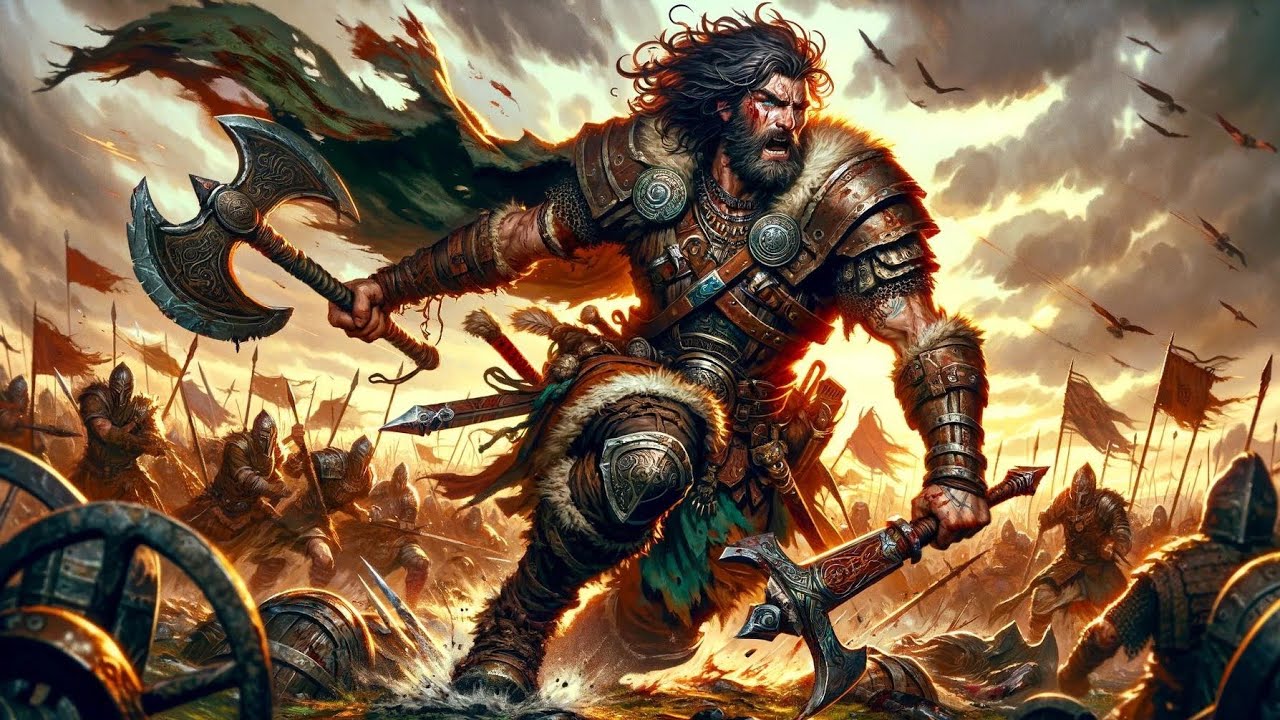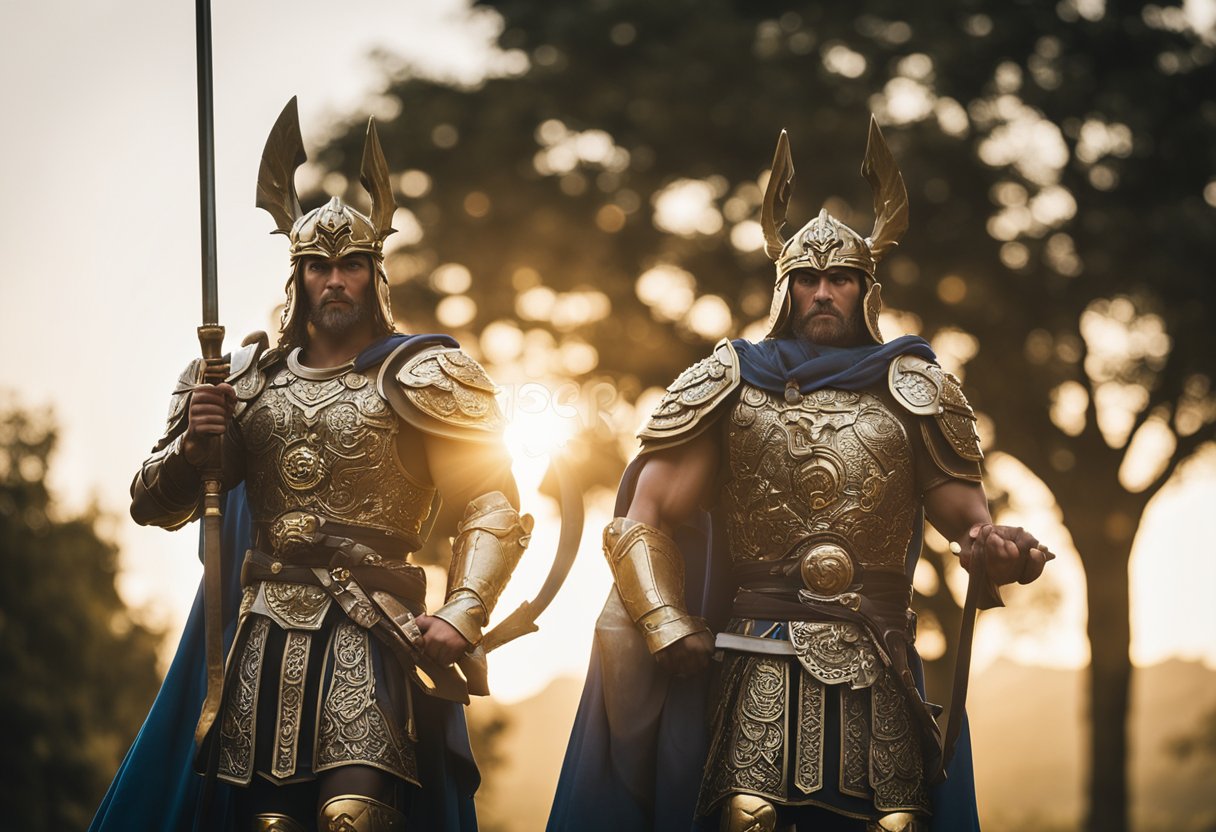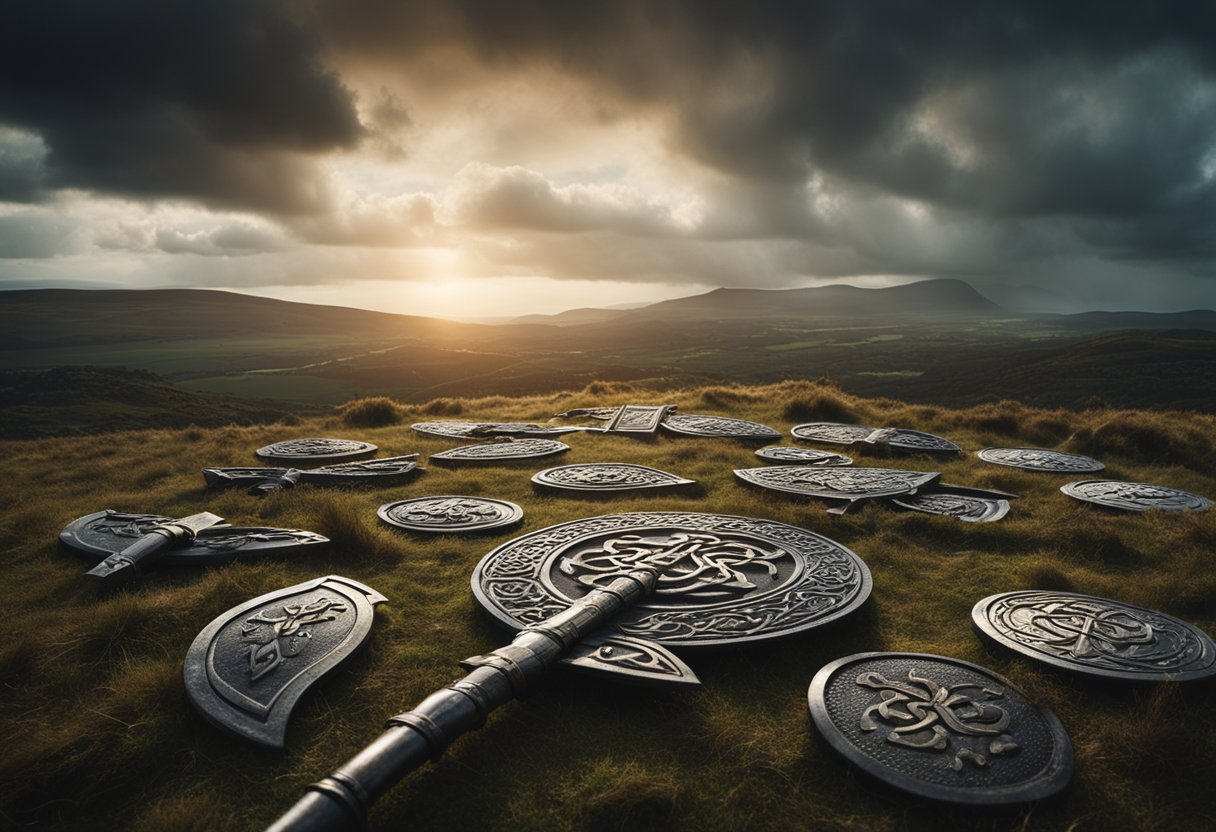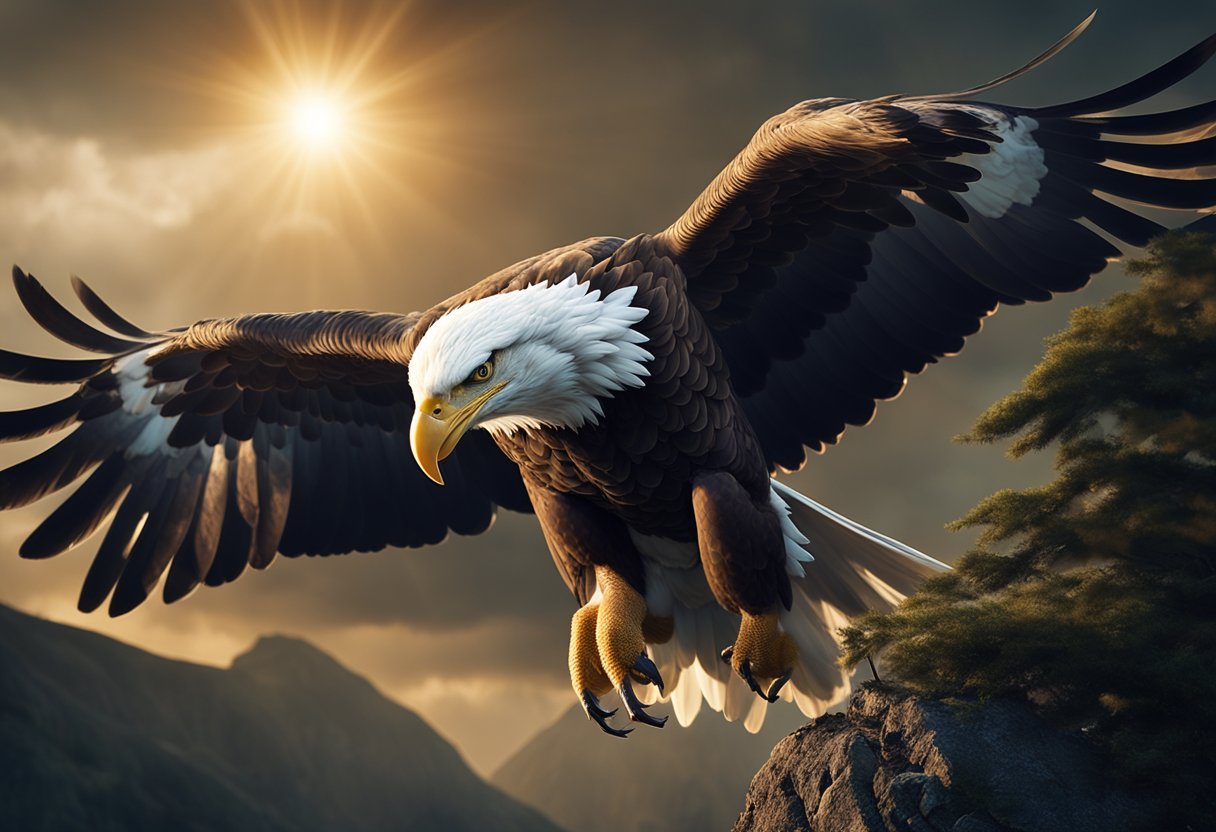Cú Chulainn and Heroes of Myth: Exploring Global Valor in Ancient Tales

Updated On: April 20, 2024 by Eman Sameh
Cú Chulainn stands at the crossroads of myth and history, a towering figure in Irish lore enveloped in the mists of the Ulster Cycle. His story, interwoven with the yarns of gods, warriors, and supernatural feats, transcends the borders of his homeland to touch upon universal themes of heroism and the human condition. His exploits illuminate the pages of history as they delve into the mystical landscapes of Ireland, capturing the imaginations of generations. As with many heroes of myth, Cú Chulainn embodies the values and struggles of his people, representing a mixture of mortal fragility and the transcendent power of legends.

The annals of Irish mythology are replete with tales that speak of bravery, love, and tragedy, none more poignant than those surrounding Cú Chulainn. His purportedly divine lineage set the stage for a life of formidable challenges and heroic deeds. These narratives not only unravel the complex fabric of Cú Chulainn’s own saga but also provide a glimpse into the soul of an ancient culture. The resonance of his tale underscores the enduring legacy of the Ulster heroes, whose stories have been carved into the cultural consciousness, echoing the values that shaped a nation.
The Historical Context of Irish Mythology

It’s pivotal to explore the layers of Irish mythology by understanding the historical framework within which these rich narratives were woven. Centuries of political and cultural undercurrents have shaped the legends, with figures like Cú Chulainn growing beyond mere stories to embody the spirit of Ireland itself.
The Ulster Cycle
The Ulster Cycle, one of the four main cycles of Irish mythology, stands as a significant testament to ancient Irish culture. It comprises a collection of epic tales set around the reign of Conchobar mac Nessa, the King of Ulster. Central to this cycle is the hero Cú Chulainn, whose extraordinary feats and tragic destiny are detailed in stories like the Táin Bó Cúailnge (The Cattle Raid of Cooley). These narratives offer entertainment and illustrate the complexities of honour, loyalty, and valour within the ancient Ulster society. The tales within the Ulster Cycle are thought to originate in the first century BCE, chronicling a time when Ireland was a tapestry of petty kingdoms and warrior elites.
The Influence of Irish Political History
The influence of Irish political history on mythology cannot be understated. Significant events like the 1916 Easter Rising were pivotal in shaping Irish nationalism, deeply resonating within the collective consciousness and aligning closely with the themes of heroism found in these ancient myths. Irish nationalists looked to figures like Cú Chulainn as emblematic of resistance against oppression, with the warrior’s image often invoked as a symbol of valour amongst rebels.
The dichotomy between Irish nationalists and unionists also finds echoes in the age-old stories, with factional conflicts and the struggle for sovereignty echoing down through the centuries to influence Irish culture and identity. Our reflections on these legends provide an escape into a fantastical past and a lens through which to view our historical identity.
Birth and Early Years of Cú Chulainn
The early life of Cú Chulainn is characterised by remarkable events that prelude his legendary status in Irish mythology. From his unusual birth to his extraordinary feats during boyhood, we’ll explore the pivotal moments that shape the hero’s youth.

The Prodigy’s Origins
Cú Chulainn’s origins are as extraordinary as his feats. Our hero was born with the name Sétanta, the son of Dechtire, sister to Conchobar mac Nessa, the king of Ulster. His birth entwines the mortal and the divine, as his father is none other than the god Lugh of the Long Arm, giving him traits befitting a demi-god. The mystical touches on the circumstances of his birth, with Dechtire consuming a mayfly, leading to his conception.
Boyhood Deeds
Cú Chulainn displayed incredible abilities from a tender age, outperforming peers in feats of strength, agility, and skill. His boyhood deeds are legendary, showcasing a physical prowess and combat aptitude beyond his years. Legends tell of Cú Chulainn single-handedly defending Ulster from invaders while still a child, a testament to his prodigious martial capabilities.
Taking of Arms
The taking of arms is a significant rite of passage for a young warrior, and for Cú Chulainn, it was a pivotal event. At a mere seven years of age, he deemed himself ready, and upon approaching King Conchobar, he was granted his request. This moment marked his transition from boy to warrior, and soon after, the name Cú Chulainn – the Hound of Culann – was earned after he valiantly replaced the guard dog he accidentally killed at the smith Culann’s house. This act sealed his fate, intertwining his path with legend and foretelling the valorous deeds that would define his legacy.
Key Figures in Cuchulainn’s Tales
In the epic tales of Cuchulainn, each character plays a pivotal role that shapes the hero’s journey. From formidable mentors to relentless adversaries, these figures are critical to the rich tapestry of stories within the Ulster cycle.
Mentors and Allies
Scáthach
- Role: Mentor, Warrior
- Notable Contributions: Trained Cú Chulainn in the arts of war, imparting skills that proved vital in his subsequent battles.
- Affiliation: Ally
Emer
- Role: Lover, Spouse
- Notable Contributions: Emer’s cleverness and love for Cú Chulainn were crucial throughout his life, offering support and wisdom.
- Affiliation: Ally
Culain
- Role: Smith, Host
- Notable Contributions: Provided a namesake incident when Cú Chulainn, as a child named Sétanta, killed Culain’s fierce guard dog, promising to take its place until a replacement could be reared.
- Affiliation: Ally
Antagonists and Rivals
-
- Role: Antagonist, Monarch of Connacht
- Notable Contributions: Queen Medb was a formidable foe, orchestrating the Cattle Raid of Cooley, which led to significant conflicts involving Cú Chulainn.
- Affiliation: Rival
Ferdia
- Role: Rival Warrior
- Notable Contributions: Ferdiad, friend and foster brother to Cú Chulainn, was pitted against him in a tragic duel during the Táin Bó Cúailnge.
- Affiliation: Rival
Connla
- Role: Son, Unwitting Challenger
- Notable Contributions: The tragedy of Cú Chulainn’s encounter with his son Connla, whom he unknowingly killed in combat, added to the hero’s tormented legacy.
- Affiliation: Rival (Unwittingly)
Characters like Scáthach, with her training, furthered Cú Chulainn’s prowess, making him an unparalleled warrior. Conversely, figures such as Ferdiad and Connla highlighted the complexities of loyalty and fate in Cú Chulainn’s life. Their interactions are essential to understanding the hero’s narrative.
Pivotal Myths and Legends
Delving into Ireland’s mythical tapestry, we encounter stories woven with valor and supernatural feats that continue to captivate us. Central to these tales is the figure of Cúchulainn, a hero whose deeds stretch far beyond the shores of Ireland, echoing in the hearts of those who value heroism and bravery.
Táin Bó Cúailnge
The Táin Bó Cúailnge or the Cattle Raid of Cooley stands as one of the most celebrated sagas in Irish mythology. This epic narrative details the colossal struggle to possess the extraordinary Brown Bull of Cooley, a beast of unmatched value and strength. Cúchulainn’s role in the Táin is pivotal; he stands as the lone defender of Ulster, facing waves of warriors sent by Queen Medb of Connacht. Among these confrontations lies the deeply personal and tragic duel with his friend, Ferdiad—a battle that exemplifies the complexity of heroism and loyalty.
Cúchulainn’s Other Adventures
Aside from the legendary cattle raid, the chronicles of Cúchulainn’s feats are numerous. In Aided Con Culainn, we witness the end of our hero, a poignant reminder of the mortality that lurks even within those of demi-god lineage. The narrative unfolds Cúchulainn’s vulnerability, ultimately leading to his demise—starkly contrasting his near-invincible image in prior battles. These stories do not merely recount the might of a warrior but also explore themes of heroism, honour, and the tragic costs of war.
Through these myths and legends, we partake in a journey that transcends mere entertainment. They afford us a profound glimpse into the ethos of a bygone era and offer lessons that remain relevant today.
Cú Chulainn’s Love Life
Cú Chulainn’s romantic pursuits were as legendary as his feats in battle, marked by profound affection and fraught encounters with formidable women warriors.
Emer: The Chief Love
Emer, the daughter of Forgall Monarch, was Cú Chulainn’s most esteemed love. Their union was forged by an unparalleled bond. Despite the numerous challenges he faced to win her affection, including the completion of impossible tasks, Cú Chulainn’s dedication never wavered. His determination and the aid of his divine father Lugh ensured their eventual marriage.
Other Romances
While Emer was his principal love, Cú Chulainn did have encounters with other women. Notably, while training with the warrior woman Scáthach, he was entwined with Aife, Scáthach’s rival. This encounter was a complex mix of admiration, desire, and the exigencies of war, resulting in a brief but intense connection. These experiences with women warriors like Aife and Scáthach exerted a lasting influence on Cú Chulainn’s life.
Supernatural Elements and Prophecies
In exploring the rich tapestry of Irish mythology, we encounter a realm where the supernatural intersects with heroism and where prophecies shape the destinies of its champions. The legendary figure of Cú Chulainn exemplifies this fusion, with his saga steeped in magical abilities and divine encounters.
Magical Abilities and Weapons
Cú Chulainn boasts an arsenal of magical weapons and abilities, most notably the Gáe Bolga. This fearsome spear, bestowed upon him by his teacher, Scáthach, requires a unique technique to wield and is infamous for inflicting mortal wounds that cannot be healed. Due to his demigod ancestry, being the son of the deity Lugh, Cú Chulainn’s prowess in battle is unparalleled; his martial feats often appear as acts of sorcery rather than mere skill.
Taboos, or geasa, are another supernatural aspect entwined with Cú Chulainn’s life. These prohibitions, if broken, could lead to disastrous consequences, and thus, they held a prophecy-like significance over the hero’s fate.
Encounters with Deities
The presence of deities in Cú Chulainn’s life introduces an intriguing divine layer to his story. Among these is The Morrígan, the goddess of fate and war. She frequently appears in tales foretelling doom or offering cryptic guidance. Her interactions with Cú Chulainn blend adversarial challenges and prophetic revelations, alluding to the intertwined nature of mortal and divine destinies.
Our champion’s divine father, Lugh, instills him with supernatural virtues and gifts, situating him as a bridge between the mortal and godly realms. This celestial lineage imbues Cú Chulainn with a sense of predestined greatness, further augmented by prophetic elements that foreshadow his legendary exploits and tragic demise.
Symbols and Archetypes
In the pantheon of mythological heroes, figures like Cú Chulainn stand as towering archetypes with universal themes that resonate across cultures.
Cú Chulainn as Irish Achilles
Much like Achilles, Cú Chulainn embodies the tragic hero archetype, renowned not only for his prowess in battle but also for his fated mortality. He carries exceptional skills and a singular, iconic weapon, the Gáe Bolga, which unleashes unspeakable damage upon its targets, mirroring Achilles’ dreaded spear. Both heroes share a common thread of invincibility with singular points of vulnerability, reinforcing the motif that even the greatest among us have their weaknesses.
Animal Imagery in Cú Chulainn’s Story
Animal symbols are rife within the tale of Cú Chulainn, with the Hound of Ulster as a central emblem, signifying loyalty, protection, and ferocity. His steed, Liath Macha, further accentuates his connection with the animal kingdom, representing sovereignty and the formidable forces of nature. The transformation of Cú Chulainn during his warp spasm invokes raw, primal power, a metamorphosis from the human to the superhuman, encapsulating the theme of unleashing one’s inner beast to surmount insurmountable odds.
Cuchulainn’s Death
The Death of Cuchulainn is a poignant tale of heroism entwined with tragedy, marked by a prophecy that sealed his fate and a final stand that defined his enduring legacy.
Foretold Demise
The downfall of Cuchulainn, a legendary figure from the Ulster Cycle, was predestined by prophecies laden with misfortune. Guided by his father, the deity Lugh, Cuchulainn achieved many feats in his lifetime. Yet, the forewarnings of his end loomed ominously over his heroic pursuits. It was foretold that his extraordinary gifts would ultimately lead to a premature and sorrowful death.
The Hero’s Final Stand
In his final battle, Cuchulainn stood valiantly despite grievous wounds and a tide of adversaries. Legends recount his determination to remain upright even as his life ebbed; he tied himself to a standing stone, ensuring he faced his enemies with an unyielding spirit. This testament to his bravery roused deep mourning throughout Ulster as the demise of their greatest warrior signalled an irreplaceable loss. Cuchulainn’s fierce loyalty and unparalleled valour were immortalised in this profound act of defiance against the inevitability of death.
Art and Modern Depictions
Cú Chulainn’s lore transcends time, influencing a range of artistic expressions from statues to modern media, evidencing the demigod’s continued relevance.
Statues and Visual Arts
In the realm of statues and visual arts, the bronze figure of Cú Chulainn, sculpted by Oliver Sheppard, stands as a poignant embodiment of Irish mythological heritage. It resides in the General Post Office (GPO) in Dublin as a symbol of nationalist pride. The sculpture serves not only as art but as a testament to Ireland’s spirit. Moreover, contemporary visual artists continue to draw upon this iconic figure, contributing to the rich tapestry of Celtic-inspired artwork that permeates both galleries and public spaces.
Cú Chulainn in Popular Media
When it comes to Cú Chulainn in popular media, his story has been adapted across various formats, including literature, comic books, and potentially anime. Each interpretation offers a different lens through which to view this storied hero. In literature, the figure of Cú Chulainn often serves as a complex protagonist or an inspirational archetype. The comic book domain has seen the Ulster warrior leap from the page in dynamic illustrations that capture his superhuman prowess. While anime has not yet extensively featured Cú Chulainn, the potential for such an adaptation remains a tantalising prospect for fans of this storytelling medium.
The Legacy of Cú Chulainn and the Ulster Heroes
Few threads in the tapestry of Irish mythology are as vibrant as the legend of Cú Chulainn and the heroes of Ulster. They are enshrined in the annals of Irish culture, their stories spanning ancient epics to modern interpretations.
From Myth to Cultural Icon
The Ulster Cycle, the first-century literary treasure trove, speaks of Cú Chulainn’s remarkable exploits and heroism. Audiences beyond Ireland have come to know his name through translations of these narratives, such as those by Thomas Kinsella, whose work has introduced the complexities of these tales to a wider readership. The tales are more than mere stories; they serve as a cultural identity marker that has been interwoven into Irish culture and Manx folklore. Cú Chulainn himself has transcended his mythic origins to become a symbol of unwavering courage and strength, embodying the essence of heroism across cultures.
The Everlasting Fame
Cú Chulainn’s renown is undiminished by time, his legacy an everlasting fame that continues to resonate today. Celebrated in literature, art, and history, he remains a potent emblem within the shared legacy of the Celtic spirit. His stories, brimming with valour and mystique, captivate imaginations and preserve the rich tapestry of myth cherished not only in Ireland but worldwide. This hero’s tale stands as a testament to the enduring power of mythology to inspire and to mould a collective memory across generations.
Frequently Asked Questions
This section answers some of the most pressing questions about the celebrated Irish mythological figure Cúchulainn and his place in the wider context of mythological heroes.
What key themes are explored in ‘Cuchulainn and Heroes of Myth: Valor Beyond Ireland’?
The key themes of ‘Cuchulainn and Heroes of Myth: Valor Beyond Ireland’ involve exploring the valour, loyalty, and supernatural elements that define the mythological heroes of Ireland. The text reflects on the cultural importance of these characters and their stories.
Who are the main characters in ‘Cuchulainn and Heroes of Myth: Valor Beyond Ireland’?
The main characters in this narrative include Cúchulainn, renowned for his unstoppable rage and martial prowess, and prominent figures from Irish legends such as Fionn mac Cumhaill and Oisín.
Which heroes from Irish mythology are featured alongside Cúchulainn in ‘Cuchulainn and Heroes of Myth: Valor Beyond Ireland’?
Alongside Cúchulainn, other heroes from Irish mythology featured include Fionn mac Cumhaill, known for his wisdom and leadership, and the warrior woman Scáthach, who is said to have taught Cúchulainn many of his skills.
Can you summarise the narrative of Cúchulainn’s Boyhood Deeds?
Cúchulainn’s Boyhood Deeds is a tale recounting his rise to heroism, demonstrating feats of strength and bravery from a young age. It follows his journey from killing the fierce hound of Culann to his training with the warrior Scáthach, earning him the name synonymous with the ‘hound of Ulster’.
How is the name ‘Cúchulainn’ significant within Irish mythology?
The name ‘Cúchulainn’ bears great significance in Irish mythology, symbolising the boy Setanta’s transformation into a legendary hero. Upon slaying the hound of Culann, he takes on the name, ‘Culann’s Hound,’ to honour his deed and assumes the role of the hound’s replacement, protecting Ulster.
What are the deeds that led Setanta to become known as Cúchulainn?
The deeds that led Setanta to the name Cúchulainn include his defence of Ulster from invasion by single-handedly facing entire armies, notably in the epic Táin Bó Cúailnge, and his slaying of the ferocious hound guarding Culann’s estate, after which he vowed to protect Culann as his own hound would have.






